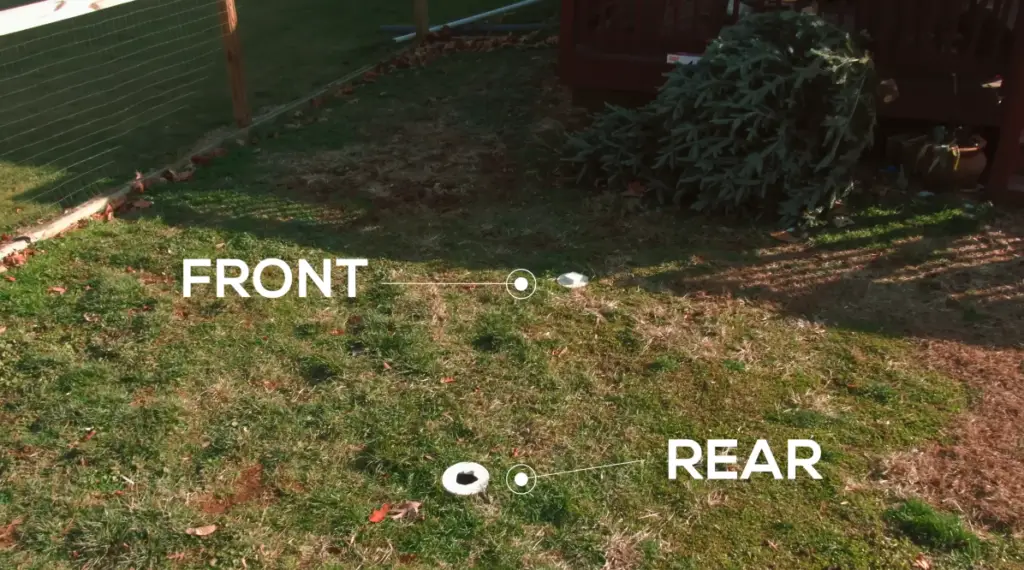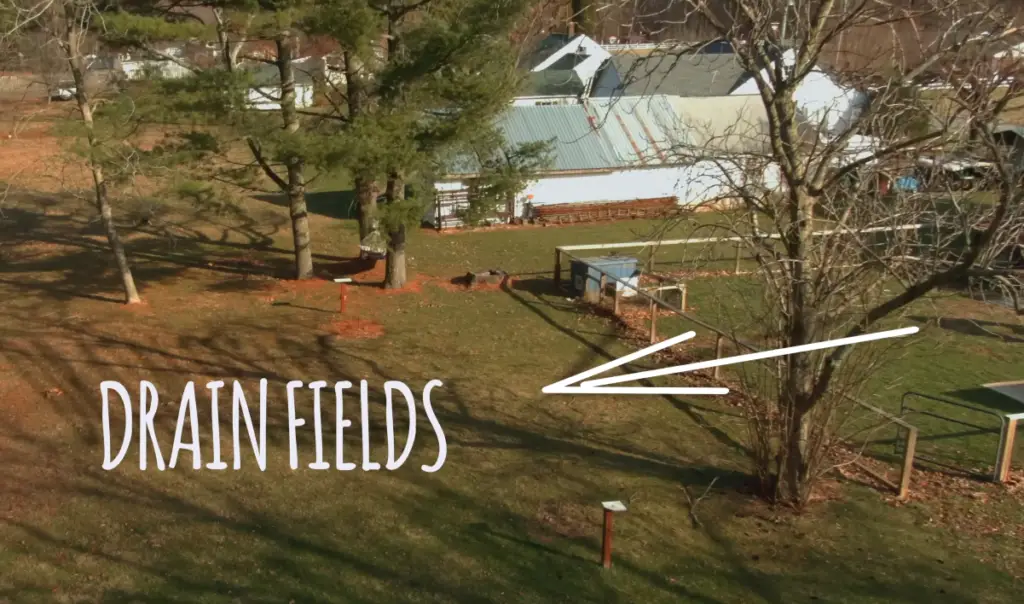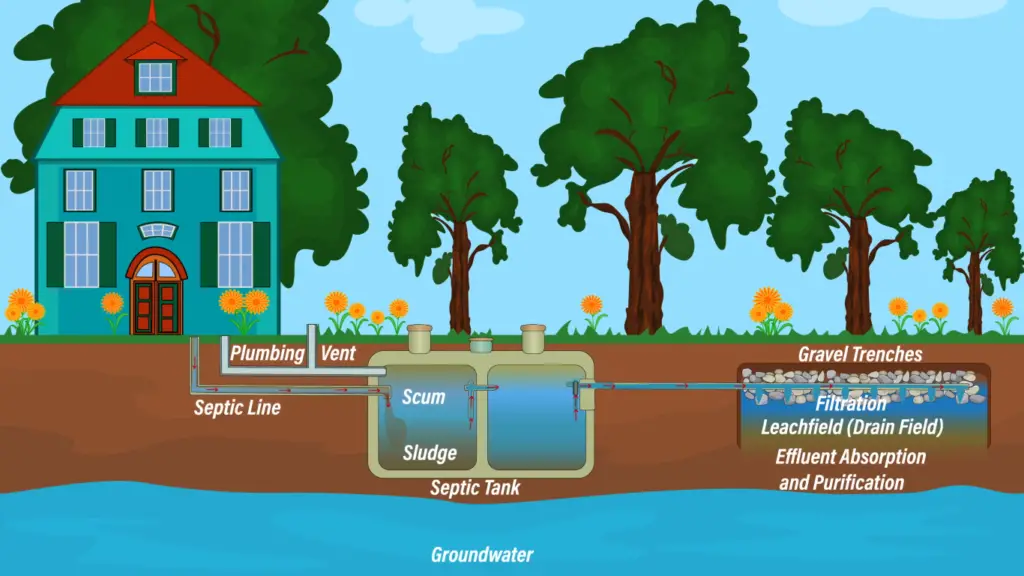Septic tanks are a necessary part of many homes, but sometimes people have questions about how they work or how far away the tank can be from the house. In this article, we will answer some of the most common questions about septic tanks. We will also provide some tips on how to maintain your system and keep it running smoothly. Let’s get started!
What distance should a septic tank be from the house?
This distance is necessary to avoid the potential health risks associated with contaminated groundwater or runoff, and to ensure the proper functioning of your system. In some cases, though not all, you may need even more space between your house and septic tank.

Certain types of soil may require additional spacing for optimal performance as well. For example, high water tables can cause flooding in areas with a shallow water table that prevents wastewater from draining properly. Additionally, if you live in an area where rainwater accumulates quickly you’ll want more than 15 feet between your home and the septic tank. [1]
In some instances building codes require greater distances between a septic tank and any structure. Make sure to check with your local government or county office for up-to-date information about specific regulations in your area.
The best way to determine the necessary distance between your house and the septic tank is to consult with a professional who can provide an expert opinion on how much space you need. A qualified installer will be able to assess your soil type, water table levels and other factors to ensure that your system is functioning properly and safely.
At the end of the day, it’s always better to err on the side of caution when determining the distance between your home and the septic tank – it’s better to be safe than sorry! With proper installation and maintenance, you can keep your septic system functioning optimally for years to come.
Where should the septic tank be placed?
The ideal location for a septic tank should be as far away from the house as possible. This is because, in the event of a leak or an overflow, sewage could contaminate your home and other nearby buildings. The recommended minimum distance between a septic tank and a dwelling is 15 feet while some local regulations require even more distance.
If you have to locate the septic tank close to the house, make sure there’s proper ventilation in place so that noxious gasses don’t build up inside your home. Additionally, any drains or pipes connected to the septic system must be properly sealed so that raw sewage doesn’t enter into your living areas.
It’s also important to consider where else you can place the tank. A septic tank should never be placed in an area with a high water table or in close proximity to any bodies of water such as streams, lakes, and rivers. Groundwater contamination is a very real risk that must be avoided at all costs.

In addition, some states require a licensed professional to investigate the soil type before installing a septic tank. Clay soils are generally unsuitable for septic tanks because they have poor drainage properties, whereas sandy soils are much better suited for this purpose.
Finally, it’s essential to ensure your septic system is installed properly and checked regularly by a qualified technician. Poor installation can lead to problems down the line and cause expensive repairs so it pays to get it done right the first time. [2]
By taking these precautions, you can ensure that your septic tank is properly placed and installed according to local regulations. With regular maintenance and care, you’ll be able to enjoy a safe and healthy home for years to come.
How far should sewage treatment be from the house?
It’s important to ensure that you are not too close to any water sources like streams or ponds as these can contaminate them with whatever is pumped out from your septic system. Additionally, ensure there is a good buffer zone between any buildings and the septic tank, in case of flooding or similar issues. [3]
When deciding on the exact location for your septic tank, take into account the following factors:
- Soil type
- Size of the drainage field
- Slope or grade of the land
- Proximity to water sources like streams, lakes, and ponds
- Distance from other buildings
In general, the further away you can put your septic tank from the house, the better. This will help minimize any potential odors as well as reduce the risk of sewage backup into your home or yard.

It’s also important to keep in mind that there may be local regulations or restrictions when it comes to installing a septic system. Check with local authorities before making any decisions so you can ensure compliance with all rules and regulations.
Finally, it’s always a good idea to hire a professional for help in determining the best location for your septic tank. They can help you to properly site the system, taking into account all of the above factors. They may also have experience in dealing with local regulations or restrictions, which can be a great benefit.
Do I need permission for a septic tank?
Yes, you do need permission to install a septic tank. Depending on where you live and the size of the tank, you may need to get a permit from your local municipality or county. In some cases, you will also have to meet certain requirements regarding its location and size. It is always best to check with your local authority before starting any project involving a septic tank.
How Far Does a Septic Tank Have to Be From a Well?
If you’re installing a septic system, the distance of the tank from a well is an important consideration. The truth is, there’s no single answer. That said, in general, it’s best to keep your septic tank at least 50 feet away from any wells or sources of drinking water. This will help ensure that contaminants don’t leak out into the environment and potentially contaminate the area’s drinking supply.
Be sure to check with your local government for any additional regulations regarding well distances from septic tanks. You may also need to get approval from your county health department or environmental agency before you can start the installation of your new system. A professional installer can help guide you through this process and make sure all requirements are met.

It’s also important to keep your septic tank at least 10 feet away from any buildings, such as your house or other structures on your property. This will help prevent sewage backups and other problems that can arise from having the tank too close to your home. Additionally, make sure to leave enough room for a service truck should you need to do any maintenance or repairs in the future.
When it comes to installing a septic tank, guaranteeing enough distance from wells and buildings is essential for proper functioning and safety. Be sure you check with your local government and have a professional installer come out to get everything set up correctly. Taking these precautions will help ensure that your new septic tank works properly and is a safe distance away from your well.
How Far Does a Septic Tank Need to Be From a Property Line?
When it comes to septic tanks, there are several regulations that must be followed. One of these is the placement of the tank relative to a property line. It’s important to make sure that the tank is installed at least 10 feet away from any property lines or other structures on your neighbor’s land in order to avoid any potential disputes.
Additionally, if you are installing a septic tank in an area with high water table levels or areas that may experience flooding, it’s important to make sure the tank is placed at least 25 feet away from the property line. This will help prevent any potential problems caused by rising waters and keep your septic system safe. [4]
Basic safety considerations
When it comes to septic tanks and their proximity to the house, safety is always a primary concern. The first rule of thumb is that any tank should be at least three feet away from any structure, including your home. This helps protect against plumbing problems or potential contamination caused by leakage or overflow.
Additionally, if you are planning to install a new septic tank, you should also consider the terrain of your property and ensure that it is suitable for installation. If there are any hills or other obstacles like trees or large rocks in the way, they may need to be removed before installing the tank.

Another thing to keep in mind when considering how far a septic tank can be from the house is the size of your tank. Generally, tanks should be installed on level ground and away from any trees, shrubs, or other obstructions that may prevent proper maintenance in the future. In general, a septic tank should be at least five feet away from any structure and ensure that it won’t interfere with the property’s drainage system.
Finally, any septic tank should always be properly maintained and inspected on a regular basis. This is to ensure that it is functioning correctly and that there are no potential problems with the tank’s location or design. A professional plumber can help you determine the best way to maintain your septic tank, so don’t hesitate to contact one if you have any questions or concerns.
At the end of the day, safety should always be your top priority when it comes to septic tanks and how far they should be from the house. Make sure that you understand all of the safety considerations before making a final decision on where to install your tank. By doing so, you can be sure that your tank will stay safe and operational for years to come. And, of course, if you have any questions or concerns about the installation process don’t hesitate to contact a professional plumber who can help guide you through the process.
Tips for a successful installation
- Make sure the tank is buried deep enough – The depth at which you bury your septic tank is important for its proper functioning. Generally, it needs to be at least 4 feet deep.
- Install a baffle wall – This will help keep large objects out of the system and keep any heavy sediment from entering the tank.
- Make sure the tank is installed on level ground – Your septic system needs to be placed on a flat surface so that it can hold and distribute wastewater properly.
- Perform regular maintenance – Regularly pumping your septic tank and cleaning any filters or baffles in place will help ensure your system is working efficiently.
- Consider your climate – Make sure you factor in the climate and weather patterns of your area when installing your system, as certain environmental conditions can affect its performance.
- Use a professional – This is especially important if you are unsure about how to install or maintain your septic system. A professional installer or septic tank specialist will be able to advise you on the best course of action.
By following these tips, you can help ensure your septic system is installed correctly and functioning optimally. This may also save you money in the long run as it prevents costly repairs or replacements down the line.
If you have any further questions about septic tank installation, maintenance, or distance from the house requirements, consult a professional for expert advice. They can provide you with specific information on your situation and help ensure your system is effective and running properly.

FAQ
How close to a house can a septic tank be?
The distance of a septic tank from the house should be determined by local governing laws. Generally, it is recommended to have at least 5 feet between the septic tank and any habitable structure. This not only ensures proper ventilation and safety but also allows for easy access for maintenance purposes.
It’s important to bear in mind that a septic tank must be accessible for regular maintenance and pumping. The area surrounding a septic tank should also be kept clear of any traffic or construction activity to prevent damage to the tank and its system components.
Where is the best place to put a septic tank?
The ideal spot for a septic tank is on higher ground, away from bodies of water and as far away from your house as possible. It should also be located in an area that’s easy to access for service and maintenance. Depending on the soil type and terrain, the perfect placement may vary slightly. Your local health department or septic installer can provide you with advice about the best location for your particular property.
Generally speaking, you’ll want to have at least 50 feet of separation between your septic tank and any buildings or other sources of contamination — which includes any nearby wells or drainage fields. This will help prevent wastewater from contaminating your drinking water supply. In some cases, especially those involving shallow soil cover, this distance may need to be greater.
Your local health department and/or septic installer should also be able to tell you what requirements must be met for distances between a septic system and nearby bodies of water — this information will vary depending on your state, county or municipality. Taking all these factors into account can help ensure that your system is properly installed and functioning correctly.
How close to a house can a sewage treatment plant be?
In general, sewage treatment plants should be as far away from a house as possible. The recommended distance for a septic tank varies depending on the type of system you are using and local regulations. Generally speaking, it is best to have your septic tank at least 10 feet away from your home’s foundation and 20-50 feet away from any other buildings or water sources. Additionally, the soil between the septic tank and the house should be well-drained to avoid groundwater contamination.
It is also important to know that if you live in an area with high ground water tables, your soil may not allow for enough drainage and thus require greater distances between your home and any sewage systems. In these cases, you may need to consult a professional to help you determine the correct distance for your system.
Finally, it is always important to check with your local municipality or county authority before installing any sewage systems near your home. They may have additional requirements and regulations that you will need to comply with in order to ensure the safe and effective operation of your septic tank.
How far does a septic tank have to be from a house in BC?
In British Columbia, the minimum separation distance between a septic tank and any building is 30 meters. The 30-meter rule applies to all buildings – including residential dwellings, sheds, outbuildings, etc. If your septic tank is located close to a property line or an existing building, you may need to move it further away in order to comply with local regulations.
It’s important to remember that each municipality has its own specific regulations when it comes to installing and maintaining a septic system. As such, before deciding on where to locate your septic tank, it’s best to check with your local government office for any additional restrictions or requirements. [5]
Finally, it’s always wise to hire a professional installer when dealing with septic systems; they can help ensure that all of your local regulations are adhered to and that the installation process goes as smoothly as possible. With their knowledge and expertise, you can rest assured that your septic tank is installed correctly and safely – minimizing the risk of costly issues down the road!
Useful Video: Your Septic System: Worst Mistakes
Conclusion
So, if you need to know how far can a septic tank be from the house, the answer is that it depends on several factors. The key considerations are the soil type and the slope of the land. Other things to remember include local regulations, maintenance schedule, tank size, and other elements specific to your property. Make sure to consult an expert when installing or replacing a septic system. With proper planning, you should be able to install an effective system that meets your needs while conforming to local requirements. Good luck!
References
- https://projectperfecthome.com/septic-tank-distance/
- https://inspectapedia.com/septic/Septic_Tank_Locations.php
- https://www.cdc.gov/nceh/publications/books/housing/cha10.htm
- https://inspectapedia.com/septic/Septic-Clearance-Distance-FAQs2.php
- https://www.bcossa.com/jv10/index.php














Leave a Reply